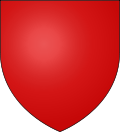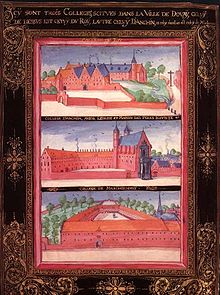- Douai
-
This article is about the French commune. For the Bible translation, see Douay-Rheims Bible.
Douai
Administration Country France Region Nord-Pas-de-Calais Department Nord Arrondissement Douai Intercommunality Douaisis Mayor Jacques Vernier
(2001–2008)Statistics Elevation 16–38 m (52–125 ft)
(avg. 24 m/79 ft)Land area1 16.88 km2 (6.52 sq mi) Population2 42,796 (1999) - Density 2,535 /km2 (6,570 /sq mi) INSEE/Postal code 59178/ 59500 1 French Land Register data, which excludes lakes, ponds, glaciers > 1 km² (0.386 sq mi or 247 acres) and river estuaries. 2 Population without double counting: residents of multiple communes (e.g., students and military personnel) only counted once. Coordinates: 50°22′17″N 3°04′48″E / 50.3713888889°N 3.08°E
Douai (Dutch: Dowaai) is a commune in the Nord département in northern France. It is a sub-prefecture of the department. Located on the river Scarpe some 40 km from Lille and 25 km from Arras, Douai is home to one of the region's most impressive belfries. The population of the metropolitan area, including Lens, was 552,682 in 1999.
Contents
Economy
The main industries in the town are in the chemical and metal engineering sectors. Renault has a huge vehicle assembly plant near the town, which has produced many well known Renault vehicles, such as the R14, R11, R19, and the Megane and Scenic of today.
Transport
The Gare de Douai railway station is served by regional trains towards Lille, Amiens, Saint-Quentin and Valenciennes.
History
Its site probably corresponds to that of a 4th century Roman fortress known as Duacum. The town became a flourishing textile market centre during the Middle Ages under the Counts of Flanders. Historically, it was known as Douay (Doway in English). In 1384, it passed into the domains of the Counts of Burgundy and thence in 1477 into Habsburg possessions.
In 1667, Douai was taken by the troops of Louis XIV of France, and by the 1668 Treaty of Aix-la-Chapelle, the town was ceded to France. During successive sieges from 1710 to 1712, Douai was almost completely destroyed.[by whom?] By 1713, the town was fully integrated into France. Apart from the ferment of the French Revolution, it was again caught up in hostilities in World War I, and in 1918, the town was partly burned, while World War II also brought considerable damage to Douai. The town is still a transportation and commercial center for the area, which is known for its coalfield, the richest in northern France.[1]
Heraldry
The arms of Douai are blazoned :
Gules simple.Main sights
Douai's ornate Gothic style belfry was begun in 1380, on the site of an earlier tower. The 80 m high structure includes an impressive carillon, consisting of 62 bells spanning 5 octaves. The originals, some dating from 1391 were removed in 1917 during World War I by the occupying German forces, who intended to melt them down for the metal. They were reinstalled after repairs in 1924, but 47 of them were replaced in 1954 to obtain a better sound. An additional larger bell in the summit, a La called "Joyeuse", dates from 1471 and weighs 5.5 tonnes. The chimes are rung by a mechanism every quarter hour, but are also played via a keyboard on Saturday mornings and at certain other times.
The substantial Porte de Valenciennes town gate, a reminder of the town's past military importance, was built in 1453. One face is built in Gothic style, while the other is of Classical design.
University of Douai
Colleges at University of Douai
Catholic studies
The University of Douai was founded under the patronage of Phillip II, when Douai belonged to the Spanish Netherlands.
It was prominent, from the 1560s until the French Revolution, as a centre for the education of English Catholics escaping the persecution in England. Connected with the University were not only the English College, Douai, founded by William Allen, but also the Irish and Scottish colleges and the Benedictine, Franciscan and Jesuit houses.
The Benedictine priory of St Gregory the Great was founded by Saint John Roberts at Douai in 1605, with a handful of exiled English Benedictines who had entered various monasteries in Spain, as the first house after the Reformation to begin conventual life. The community was established within the English Benedictine Congregation and started a college for English Catholic boys who were unable to find a Catholic education at home, and pursued studies in the University of Douai. However, the community was expelled at the time of the French Revolution in 1793 and, after some years of wandering, finally settled at Downside Abbey, Somerset, in 1814.
Another English Benedictine community, the Priory of St. Edmund, which had been formed in Paris in 1615 by Dom Gabriel Gifford, later Archbishop of Rheims and primate of France, was expelled from Paris during the Revolution, and eventually took over the vacant buildings of the community of St Gregory's in 1818. Later, following Waldeck-Rousseau's Law of Associations (1901), this community also returned to England in 1903, where it was established at Douai Abbey, near Reading. Douai School continued as an educational establishment for boys until 1999.
In 1609 the English College published a translation of the Old Testament, which, together with the New Testament published at Rheims 27 years earlier, was the Douay-Rheims Bible used by Anglophone Roman Catholics almost exclusively for more than 300 years.
For a time there was a Carthusian monastery (charterhouse) in Douai, which is now the Musée de la Chartreuse de Douai.
Modern university
Founded as University of Douai in 1562, the state university in Northern France was renamed Université impériale de Douai-Lille in 1808, then as Université de Lille with faculty expansion from Douai to Lille from mid-19th century onwards.
- Université Lille Nord de France-Artois University
- Douai Business School, established in 1991
- École des Mines de Douai
- Nurse School
Notable people
Douai was the birthplace of:
- Giambologna, born as Jean Boulogne, sculptor
- Charles Alexandre de Calonne, statesman
- Marceline Desbordes-Valmore, poet
- Henri-Edmond Cross, pointillist painter
- Michel Warlop, jazz violinist
- André Obey, playwright
- Jacky Henin, politician and Member of the European Parliament
Twin towns
Douai is twinned with:
 Harrow, United Kingdom
Harrow, United Kingdom Recklinghausen, Germany
Recklinghausen, Germany Kenosha, United States
Kenosha, United States Dédougou, Burkina Faso
Dédougou, Burkina Faso Puławy, Poland
Puławy, Poland
References
External links
- Douai official website (in French)
 Chisholm, Hugh, ed (1911). "Douai". Encyclopædia Britannica (11th ed.). Cambridge University Press.
Chisholm, Hugh, ed (1911). "Douai". Encyclopædia Britannica (11th ed.). Cambridge University Press.
Categories:- Communes of Nord
- Subprefectures in France
Wikimedia Foundation. 2010.







